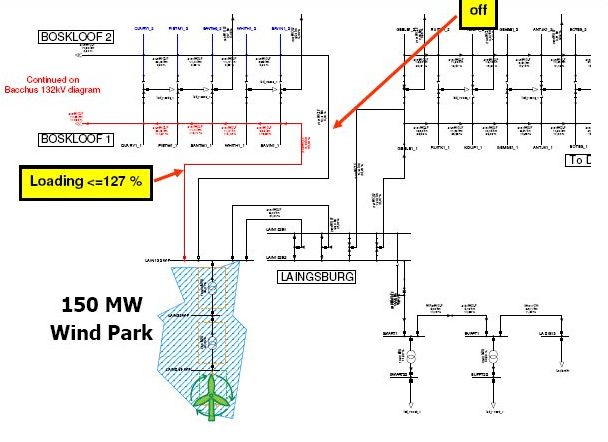Click here to register!
Grid Connection - Wind Energy
Impact on Thermal Limits in the Surrounding Subtransmission Network
In a first step, it is required to verify that the existing network capacity is able to take the additionally generated power. For this purpose, credible contingencies, such as n-1 branch outages, have to be analyzed.
An n-1 analysis based on load flow calculations of all surrounding lines leads to the conclusion that there is a thermal overload problem in the case that one circuit between (in the example that follows) Laingsburg and Boskloof is on outage and the wind farm production is above 120MW. For all other contingencies, no thermal problems can be identified.
The worst case situation with a wind farm production of 150MW and the outage of one of the parallel circuits is depicted in Figure 2. As shown in this diagram, the circuit that will remain in service will carry a load of 127% of its thermal rating.
The general options for mitigating such problems are:
- Reinforce the existing line or build a new line.
- Limit the wind farm during all times.
- Limit wind farm output in case of actual line failure (manual or automatic inter-trip).
- Consider dynamic line rating systems.
Generally, the most economic solution under the constraint that a secure network operation is ensured should be taken. However, the costs associated with each of the four options depend on
- Length of the line
- Number of hours per year during which the overload situation occurs (and during which the wind farm output would have to be limited)
For this reason, only a probabilistic assessment considering the actual wind speed conditions at the site can provide an answer to the question, which mitigation option should finally be applied.
Figure 2: Outage of one of the parallel 132kV lines between Laingsburg and Boskloof[1]
- ↑ GTZ 2009: Grid Integration of Wind Energy in the Western Cape http://www.gtz.de/de/dokumente/gtz2009-en-grid-study-western-cape.pdf




















